Samsung Q45 Review
Samsung Q45
Samsung updates the Q35 for Santa Rosa, and calls it the Q45. Does it match the excellence of its predecessor?
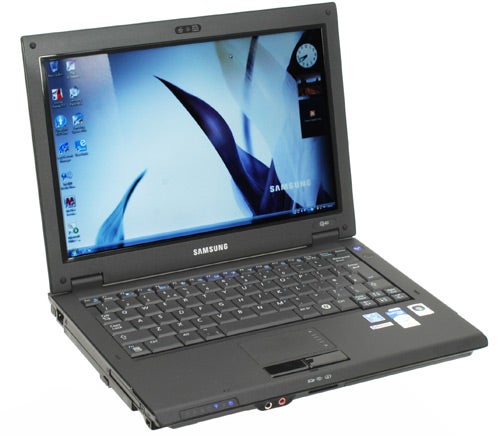
Verdict
Key Specifications
- Review Price: £759.95
In the past Samsung has done a great job of supplying the market with affordable portable notebooks in the shape of the original Q35, and its successor the Q35 Red Core 2 Duo. Both of those notebooks walked away with TrustedReviews Recommended awards, and so good were they that we felt compelled to give one away as part of our Readers Survey. Can Samsung repeat this feat with the Q35’s successor, the cannily named Q45?
As with the R20 and R70, the Q45 continues Samsung’s penchant for sleek and simple designs which feature a shiny black outer casing and matt black interior. Clearly Samsung wants to foster a unified look that can be easily identified as belonging to the company, and in this it has been pretty successful.
Other than the black finish, however, it’s clear that not a great deal about the chassis has changed. All the connections are in more or less the same places, and the overall size and shape is nigh on identical to that of the Q35. The only noticeable change comes at the front of the notebook, which has a curved shape where the Q35 was simply squared off. This is quite a nice addition too, creating a more comfortable surface on which to rest your wrists when typing.
It’s just as well then that this chassis has stood the test of time. Despite being just over a year since Riyad reviewed the original Q35, the Q45 which is based on the same design is still a fantastic chassis. Measuring 299 x 217 x 36.3 mm (WxDxH) it’s a fairly average sized notebook, the 12.1in screen is a good size and overall the Q45 couldn’t be deemed to be overly chunky or unusually slim either. However its overall weight of 1.86kg puts it on the outer fringe of the ultra-portable category, making it a very portable and convenient notebook for everyday use.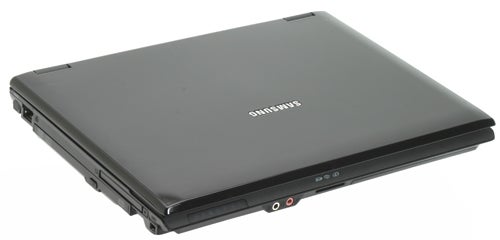
But, as with previous Q35s, not only is the Q45 eminently portable, you also get a lot for your money. Our sample came with a Santa Rosa spec Intel Core 2 Duo T7100 clocked at 1.8GHz with an 800MHz Front Side Bus. This CPU packs in all the new power saving and dynamic throttling features that Riyad wrote about in his Santa Rosa feature, and marks a significant step forward in notebook processing. Of course it’s worth remembering that the T7100 only sports 2MB of cache, as opposed to the 4MB that you get in the higher-end CPUs, but this is one of the few compromises being made in the Q45.
To accompany this there’s 2GB of 667MHz DRR2 RAM, a 5400rpm 160GB SATA hard drive, DVD-Rewriter drive and Intel X3100 integrated graphics. All of this is plugged into the Intel 965GM Express chipset, and for connectivity the Q45 features Intel PRO/Wireless 3945ABG Wi-Fi, 10/100 Ethernet and Bluetooth 2.0 EDR. The lack of Gigabit LAN or draft-n wireless is a little disappointing, as is the lack of a Turbo Memory module, but considering the price there’s no good reason to be disappointed.
So, what about that price? All in all this spec will set you back a paltry £760 inc. VAT. At this point one can only invoke the memory of a million cheap “deal of the century” TV adverts selling garden furniture, sofas and kitchens. For the price you’re getting a superb specification, and a form factor that’s as close to an ultra-portable as you’re ever likely to get this side of a £1000.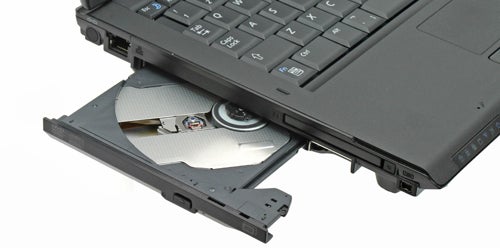
It’s not as if you’re getting what you pay for either. As with previous iterations the Q45 is studiously well made, everything about the notebook feels sturdy and reliable and gives the impressive it could survive a few bumps and scrapes. The only thing that’s potentially annoying is the propensity of the shiny black finish for attracting dust, finger marks and even scratches. This is one of the unfortunate evils of such finishes, as the iPod has demonstrated.
Although the chassis is more or less unchanged since the Q35, it’s still worth going over for posterity. On the left edge is the Ethernet port, optical drive, with a Type II PC Card slot and a four-pin FireWire port for company. Having a PC Card slot opens up the possibility of using a 3G HSDPA data card, which is always a useful investment.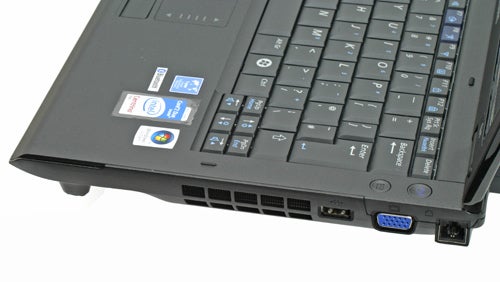
On the front are the audio connections and card reader, which supports MemoryStick, MemoryStick Pro, MMC Plus, MMC, SD and xD formats. The audio connections comprise of a combined Headphone and S/PDIF socket, and a Mic connection. There’s also a built in microphone, which is situated just above the status lights.
Moving to the right edge you’ll find a USB port, D-Sub and a modem socket, though the main heat vent takes up most of the space here. It’s worth noting too that in general use the Q45 runs very quietly, with the internal fan rarely spinning up excessively or kicking out too much heat. As a result you can comfortably use the Q45 on your lap without being burnt to crisp or, if you’re bloke, risking your future fertility.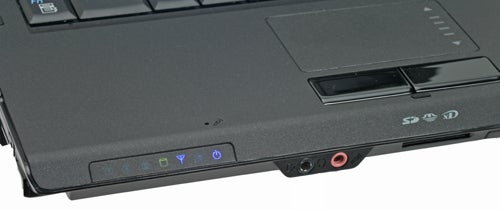
Finally on the back there is a DC-in, another USB port and a Kensington Security Lock point. As with previous iterations the battery pack sticks out the back, while if you look on the bottom of the battery there’s a handy battery level meter so you can check whether you need to charge without powering on the notebook.
Another notable addition is the 1.3 Megapixel camera, which is inconspicuously integrated into the bezel above the screen. It isn’t adjustable as some notebook webcams are, but it’s still a useful new feature and brings the Q45 in line with the large majority of competing models.
Having recently reviewed the Fujitsu-Siemens P7230 and P1610, I was struck on both occasions by the quality of their keyboards. Both were not only good to type on, but had very good layouts despite the comparative lack of space. Unfortunately, Samsung hasn’t quite managed to match those feats. 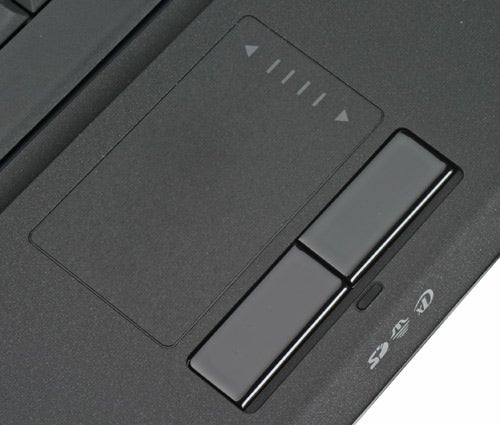
Though the keyboard itself is very pleasant to type on, the layout does have a few annoying quirks. Primary among them is the classic Left Ctrl and Fn key placement conundrum, with the Q45 having the Fn key to the left of the Ctrl key. This is always a source of annoyance, especially since the Fn key also doubles up as the Menu key which only adds to the confusion when wanting to use shortcut commands. It’s one notebook keyboard facet we’d like to see the back of, though with extended use one does get used to it.
One area where the Q45 does surpass either of the previously mentioned notebooks, however, is in the quality of its display. Given the price bracket there’s no LED backlight as on the Sony VAIO VGN-TZ11MN, but even so the display on the Q45 is very good. It’s bright and sharp, with the high contrast glossy finish helping to provide superb black levels and vibrant colour reproduction. A native resolution of 1,280 x 800 makes it ideal for 720p HD content, and any video you do play on it will look great.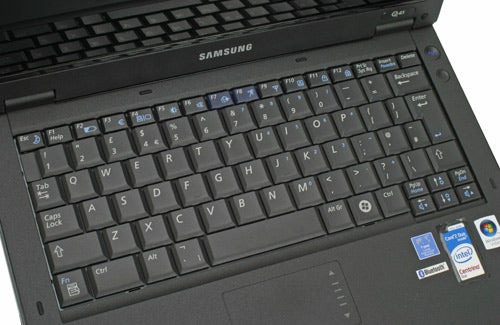
This isn’t to say it’s perfect. There is some evidence of back light bleeding from the bottom of the screen, and though fairly minor it can be a tad annoying when watching a film, while viewing angles are mediocre at best. But, again, for the price these are acceptable problems and when in front of the display you’ll enjoy what you see.
As if the value of the Q45 wasn’t clear enough, results from PC Mark 05 were extremely encouraging. Results sat between the Sony VAIO VGN-FZ11L and the Acer Aspire 5920, with the Q45 comfortably outperforming the larger and more expensive Sony in all but the Graphics and HDD tests. The Intel X3100 integrated graphics chipset is never going to provide gaming grade performance, but for a 12.1in notebook this is hardly a priority.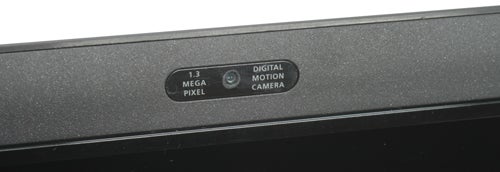
For battery testing I’ve conducted two subjective tests, the first watching a DVD with the display brightness set to full and the second a general use test using the high performance profile, wireless and display brightness on full.
After watching a one and a half hour film there was still 27 per cent of battery life remaining, which represented just under an hour of further battery to be used. Meanwhile, the general use test of word processing and Internet browsing resulted in three hours and twenty minutes of battery life before the notebook went into stand by mode. Both these results represent a pretty good return, without making any real attempt to extend battery life through reducing brightness or turning off unused components.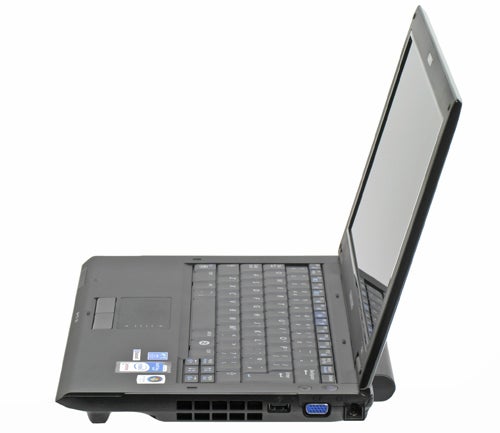
So what you have with the Q45 is a competitively priced and portable notebook, with performance and features to match. It seems as though Samsung has once again pulled out all the stops, recreating what it achieved with the Q35 and adding a new Santa Rosa CPU and chipset, along with a refreshed though fundamentally unchanged chassis. Luckily that’s all that was really needed to make this a success, and if you want portability on a budget then your search probably begins and ends here.
”’Verdict”’
If it ain’t broke, don’t fix it. Samsung has already managed great things with the Q35, and the Q45 only continues that trend. It isn’t the most complete Santa Rosa notebook out there, but at this price it hardly matters.
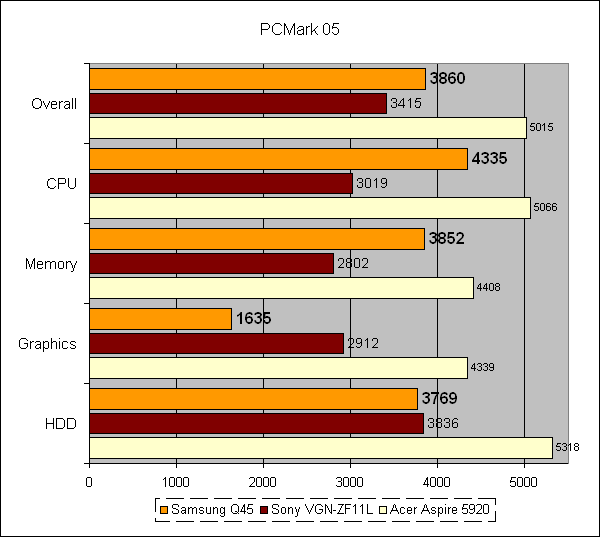
How we test laptops
Unlike other sites, we test every laptop we review thoroughly over an extended period of time. We use industry standard tests to compare features properly. We’ll always tell you what we find. We never, ever, accept money to review a product.
Trusted Score
Score in detail
-
Performance 8
-
Value 10
-
Features 7

